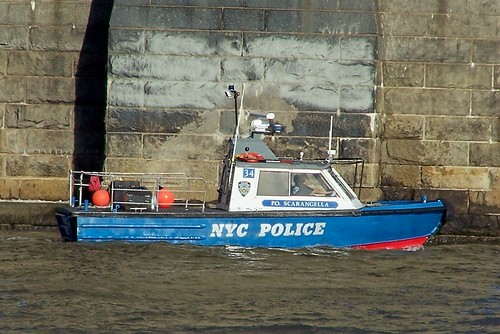
The pic above is of a boat named for PO Scarangella, taken by "Tom Hoboken", from flickr.
One morning, I happened to have actually had a cup of coffee prior to getting on the train, and was looking at the wonderful view of lower Manhattan across to the Brooklyn bridge when I saw the harbor police boat... The police officer appeared to be throwing something overboard, perhaps an anchor... The boat appears to be there every morning, and it seems like it would be a wonderful job- to be paid to sit on a boat in the morning and watch the sunrise and just hang out with the waves rocking against your boat...then I thought about it some more, since my secret ambition apart from working an emergency department would be to save lives on the water... What does the harbor patrol officer do?
Is this part of the counter-terrorism effort? Does this boat come to the assistance of people who fall off ferries? Shouldn't the Coast Guard be doing this instead of interdicting drug traffickers? Then the terrible thought crossed my mind.. do they look for jumpers ? Are they paramedics, all set up to intubate the jumper with signs of life? Do they do chest tubes for the inevitable pneumos and have a thoracotomy set up?
I did a little research, and found the story of a woman who apparently jumped from the bridge and was rescued, a Boston paramedic assigned to harbor patrol who hilariously tells the story of a Chinese sailor talking back to Coast Guard dispatch, "never mind color of boat! halfway down!,you come now!", a feral cat rescued from a liveaboard boat by a California harbor patrol, a story about a man who jumped off a gay pride party yacht and was then shot and killed after scuffling with harbor police after his rescue, a story about a beaver rescued from the East River while Harbor Police were on patrol during the Pope's visit to NYC, and a piece about kayakers who got too close to the waterfalls and had to be pulled out of the East River, and the interdiction of drug smugglers by police divers who have been known to sleep in the rudder compartment of cargo ships.
So that's what they do!
While looking around, I found an impressive collection of photos of water traffic in this blog about New York Harbor...